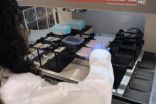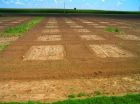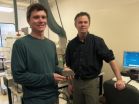(Press-News.org) In recent years, developers have been investigating light-harvesting thin film solar panels made from nanotechnology –– and promoting efficiency metrics to make the technology marketable. Now a Tel Aviv University researcher is providing new evidence to challenge recent "charge" measurements for increasing solar panel efficiency.
Offering a less expensive, smaller solution than traditional panels, Prof. Eran Rabani of Tel Aviv University's School of Chemistry at the Raymond and Beverly Sackler Faculty of Exact Sciences puts a lid on some current hype that promises to increase efficiencies in thin film panels. His research, published recently in the journals Nano Letters and Chemical Physics Letters, may bring the development of new solar energy technologies more down to earth.
Prof. Rabani combines a new theoretical approach with computer simulations. "Our theory shows that current predictions to increase efficiencies won't work. The increase in efficiencies cannot be achieved yet through Multiexciton Generation, a process by which several charge carriers (electrons and holes) are generated from one photon," he says.
Inefficient as "charged"
But both new and existing theories bode well for the development of other strategies in future solar energy technology, he points out. Newer approaches published in journals such as Science may provide means for increasing the efficiencies of solar technology, and perhaps would also be useful in storage of solar energy, Prof. Rabani and his team of researchers believe.
A chemical physicist, Prof. Rabani investigates how to separate charges from the sun efficiently. In 2004, physicists suggested that more than one electron-hole pair could be pulled from one photon in a complicated process in semiconductor nanocrystals. If this were possible, the charge would be doubled, and so the solar energy efficiency would increase. "We've shown that this idea doesn't work," Prof. Rabani says.
One step closer to marketing the sun
The development of more efficient and less expensive devices to make use of solar energy is one of the greatest challenges in science today. Billions of dollars are being spent to find the best methods to collect electron "charges" from the sun.
Typically, one photon from the sun absorbed in a thin film solar panel can excite one electron-hole pair, which is then converted to electricity. Currently there are claims that if more electron-hole pairs can be excited after the photon is absorbed, a larger fraction of the photon energy can successfully be converted into electricity, thus increasing device efficiency.
The theory that Prof. Rabani developed with his Israeli colleagues shows why this process is not as efficient as originally conceived. It's bad news for panel producers looking to create more efficient solar panels, but good news for researchers who are now free to look to the next realistic step for developing a technology that works.
Prof. Rabani is now on sabbatical at the University of California, Berkeley as a Miller Visiting Professor.
INFORMATION:
American Friends of Tel Aviv University (www.aftau.org) supports Israel's leading, most comprehensive and most sought-after center of higher learning. Independently ranked 94th among the world's top universities for the impact of its research, TAU's innovations and discoveries are cited more often by the global scientific community than all but 10 other universities.
Internationally recognized for the scope and groundbreaking nature of its research and scholarship, Tel Aviv University consistently produces work with profound implications for the future.
Debunking solar energy efficiency measurements
Tel Aviv University 'recalculates' efficiency paradigm for thin film solar panels
2011-01-11
ELSE PRESS RELEASES FROM THIS DATE:
Study identifies new genetic signatures of breast cancer drug resistance
2011-01-11
A new study conducted by Josh LaBaer's research team in the Biodesign Institute at Arizona State University has pinpointed more than 30 breast cancer gene targets ---including several novel genes---that are involved in drug resistance to a leading chemotherapy treatment.
The results of the study may one day aid in the treatment of the one in ten U.S. women who will develop breast cancer, by empowering physicians with a more personalized approach to therapy as well as a new tool for the early screening of those that may ultimately become resistant to chemotherapy.
Drugs ...
Study estimates land available for biofuel crops
2011-01-11
CHAMPAIGN, Ill. — Using detailed land analysis, Illinois researchers have found that biofuel crops cultivated on available land could produce up to half of the world's current fuel consumption – without affecting food crops or pastureland.
Published in the journal Environmental Science and Technology, the study led by civil and environmental engineering professor Ximing Cai identified land around the globe available to produce grass crops for biofuels, with minimal impact on agriculture or the environment.
Many studies on biofuel crop viability focus on biomass yield, ...
Miscanthus has a fighting chance against weeds
2011-01-11
University of Illinois research reports that several herbicides used on corn also have good selectivity to Miscanthus x giganteus (Giant Miscanthus), a potential bioenergy feedstock.
"No herbicides are currently labeled for use in Giant Miscanthus grown for biomass," said Eric Anderson, an instructor of bioenergy for the Center of Advanced BioEnergy Research at the University of Illinois. "Our research shows that several herbicides used on corn are also safe on this rhizomatous grass."
M. x giganteus is sterile and predominantly grown by vegetative propagation, or planting ...
Lake Erie hypoxic zone doesn't affect all fish the same, study finds
2011-01-11
WEST LAFAYETTE, Ind. - Large hypoxic zones low in oxygen long have been thought to have negative influences on aquatic life, but a Purdue University study shows that while these so-called dead zones have an adverse affect, not all species are impacted equally.
Tomas Höök, an assistant professor of forestry and natural resources, and former Purdue postdoctoral researcher Kristen Arend used output from a model to estimate how much dissolved oxygen was present in Lake Erie's hypoxic zone each day from 1987 to 2005. That information was compared with biological ...
Being poor can suppress children's genetic potentials
2011-01-11
AUSTIN, Texas — Growing up poor can suppress a child's genetic potential to excel cognitively even before the age of 2, according to research from psychologists at The University of Texas at Austin.
Half of the gains that wealthier children show on tests of mental ability between 10 months and 2 years of age can be attributed to their genes, the study finds. But children from poorer families, who already lag behind their peers by that age, show almost no improvements that are driven by their genetic makeup.
The study of 750 sets of twins by Assistant Professor Elliot ...
Possible missing link between young and old galaxies
2011-01-11
University of California, Berkeley, astronomers may have found the missing link between gas-filled, star-forming galaxies and older, gas-depleted galaxies typically characterized as "red and dead."
In a poster to be presented this week at the American Astronomical Society meeting in Seattle, UC Berkeley astronomers report that a long-known "early-type" galaxy, NGC 1266, is expelling molecular gas, mostly hydrogen, from its core.
Astronomers have long recognized the distinction between early-type red and dead galaxies, thought to be largely devoid of gas and dust and ...
Oxygen-free early oceans likely delayed rise of life on planet
2011-01-11
RIVERSIDE, Calif. – Geologists at the University of California, Riverside have found chemical evidence in 2.6-billion-year-old rocks that indicates that Earth's ancient oceans were oxygen-free and, surprisingly, contained abundant hydrogen sulfide in some areas.
"We are the first to show that ample hydrogen sulfide in the ocean was possible this early in Earth's history," said Timothy Lyons, a professor of biogeochemistry and the senior investigator in the study, which appears in the February issue of Geology. "This surprising finding adds to growing evidence showing ...
Does it hurt?
2011-01-11
It is well known that pain is a highly subjective experience. We each have a pain threshold, but this can vary depending on distractions and mood. A paper in the International Journal of Behavioural and Healthcare Research offers a cautionary note on measuring perceived pain in research.
There are many chronic illnesses and injuries that have no well-defined symptoms other than pain, but because of the subjectivity in a patient's reporting of their experience of the illness or injury, healthcare workers have difficulty in addressing the patient's needs. Moreover, when ...
New method takes snapshots of proteins as they fold
2011-01-11
People have only 20,000 to 30,000 genes (the number is hotly contested), but they use those genes to make more than 2 million proteins. It's the protein molecules that domost of the work in the human cell. After all, the word protein comes from the Greek prota, meaning "of primary importance."
Proteins are created as chains of amino acids, and these chains of usually fold spontaneously into what is called their "native form" in milliseconds or a few seconds.
A protein's function depends sensitively on its shape. For example, enzymes and the molecules they alter are ...
Universities miss chance to identify depressed students
2011-01-11
CHICAGO --- One out of every four or five students who visits a university health center for a routine cold or sore throat turns out to be depressed, but most centers miss the opportunity to identify these students because they don't screen for depression, according to new Northwestern Medicine research.
About 2 to 3 percent of these depressed students have had suicidal thoughts or are considering suicide, the study found.
"Depression screening is easy to do, we know it works, and it can save lives," said Michael Fleming, professor of family and community medicine ...
LAST 30 PRESS RELEASES:
Sleeping in on weekends may help boost teens’ mental health
Study: Teens use cellphones for an hour a day at school
After more than two years of war, Palestinian children are hungry, denied education and “like the living dead”
The untold story of life with Prader-Willi syndrome - according to the siblings who live it
How the parasite that ‘gave up sex’ found more hosts – and why its victory won’t last
When is it time to jump? The boiling frog problem of AI use in physics education
Twitter data reveals partisan divide in understanding why pollen season's getting worse
AI is quick but risky for updating old software
Revolutionizing biosecurity: new multi-omics framework to transform invasive species management
From ancient herb to modern medicine: new review unveils the multi-targeted healing potential of Borago officinalis
Building a global scientific community: Biological Diversity Journal announces dual recruitment of Editorial Board and Youth Editorial Board members
Microbes that break down antibiotics help protect ecosystems under drug pollution
Smart biochar that remembers pollutants offers a new way to clean water and recycle biomass
Rice genes matter more than domestication in shaping plant microbiomes
Ticking time bomb: Some farmers report as many as 70 tick encounters over a 6-month period
Turning garden and crop waste into plastics
Scientists discover ‘platypus galaxies’ in the early universe
Seeing thyroid cancer in a new light: when AI meets label-free imaging in the operating room
Neutrophil-to-lymphocyte ratio may aid risk stratification in depressive disorder
2026 Seismological Society of America Annual Meeting
AI-powered ECG analysis offers promising path for early detection of chronic obstructive pulmonary disease, says Mount Sinai researchers
GIMM uncovers flaws in lab-grown heart cells and paves the way for improved treatments
Cracking the evolutionary code of sleep
Medications could help the aging brain cope with surgery, memory impairment
Back pain linked to worse sleep years later in men over 65, according to study
CDC urges ‘shared decision-making’ on some childhood vaccines; many unclear about what that means
New research finds that an ‘equal treatment’ approach to economic opportunity advertising can backfire
Researchers create shape-shifting, self-navigating microparticles
Science army mobilizes to map US soil microbiome
Researchers develop new tools to turn grain crops into biosensors
[Press-News.org] Debunking solar energy efficiency measurementsTel Aviv University 'recalculates' efficiency paradigm for thin film solar panels






